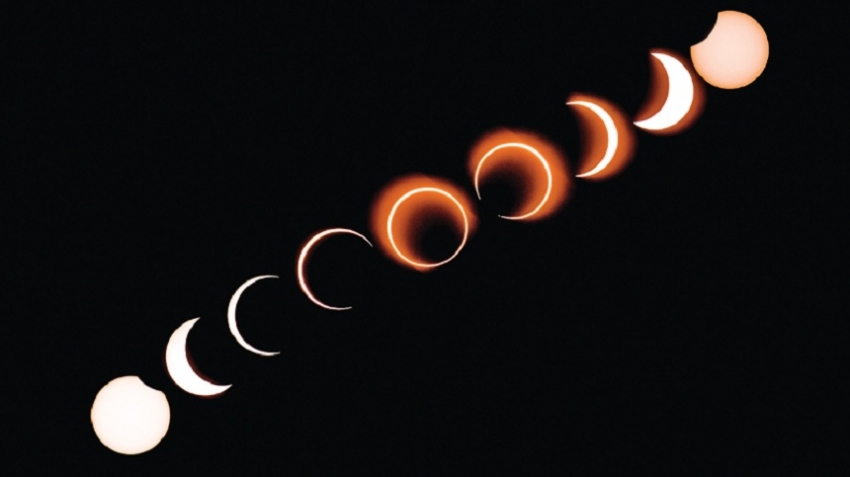On the day after the Christmas, Thursday December 26, 2019, an annular solar eclipse was observed from Sri Lanka. The Annular phase of the eclipse began approximately 180 kilometres West of Dammam in the desert of eastern Saudi Arabia. The greatest eclipse happened when the axis of moon’s shadow becomes shortest at 010 00.3’ N latitude and 1020 16.5’ E longitude close to Padang Island in Sumaththra, Indonesia.
All solar eclipses involve when the Moon’s elliptical orbit which 50 inclined to the plane of the Earth’s orbit (ecliptic), passing between the Earth and the Sun. When the Moon’s orbit crosses the ecliptic plane at the points referred as nodes, the Moon casts a shadow on the Earth. Depending on whether the Moon passes directly, or only partly, between the Earth and Sun, and the location on Earth you stand to observe it, the solar eclipse can be divided as Total, Partial, Annular and Hybrid. The other very important factor which determines the type of the eclipse is the anomalistic month. The moon takes 27.554549 days to travel from apogee to perigee and back again during the anomalistic month. The Apogee is the point in the Moon’s orbit that is farthest from the Earth and the Perigee is the point in the orbit of the Moon that is closest to the Earth. Therefore the types of the eclipse as well as the size of the eclipse depend on the distance from the Earth to the Moon during the eclipse; and this distance depends on the point during the Anomalistic Month when the eclipse occurs.
In a Total solar eclipse the Sun is completely covered by the Moon on New Moon day where the moon is at a point relatively close to the Earth in its elliptical orbit. During a total eclipse the shadow known as umbra is casted by the moon totally obscured the Sun. People standing on those parts of the Earth, within the Umbra, observe the Sun’s face completely hidden by the Moon.
Outside the umbra where the Sun is only partly covered by the Moon; this is known as the penumbra, and it covers a much larger area of the Earth than the umbra. The area of the Earth which falls within the penumbra sees a Partial eclipse of the Sun.
Annular eclipse occurred when the Moon is in its elliptical orbit farther from the Earth. This results that the umbra is too short to reach the Earth. However, the Moon is directly in front of the Sun, so the parts of the Earth right-underneath it, see the antumbra where the center of the Sun is covered. This leaves a ring, an annulus, of the Sun visible round the edges of the Moon. Penumbra is also visible just outside the antumbra.
There are two basic things to be satisfied to occur an eclipse (i.e. either solar eclipse or lunar eclipse) One is, the Moon should be at one of the two nodes while the other is, the Moon also has to be aligned with the Earth and the Sun, i.e. at a New Moon (producing a solar eclipse) or Full Moon (for a lunar eclipse). The periods governing these two cases are determined by Draconic month and Synodic Month.
A Draconic Month is the time, 27.212220 days, taken for the Moon to return to the starting node. This time is shorter than its orbital period. This is because of the precession of the Moon’s orbit; the Moon’s orbital plane, and hence the nodes, rotate backwards around the Earth about once every 18.6 years.
The Synodic Month is the time, on average 29.530589 days, takes for the Moon to go from one New Moon to the next. This time is longer than the orbital period (sidereal month) of the moon because the Moon’s orbital period is the time it takes for the Moon to complete one orbit around the Earth.
When these two cycles coincide, an eclipse occurs. Almost after 223 Synodic months and 242 Draconic months, 18 years, 10 days and 8 hours, this coincidence occurs and produce similar eclipses. The period of 18 years, 10 days and 8 hours is known as Saros. Saroscycle, means “repetition”, where similar eclipses happen every 18 years 10 or 11 days and 8 hours.
Therefore Saros series indicates that a series in which similar eclipses happen every 18 years 10 or 11 days and 8 hours. About 70 to 85 eclipses occur during a Saro series over 1,200 to 1,500 years. Each series starts with a small partial eclipse in either the north or south Polar Regions. Therefore first total eclipse will be seen near the Polar Regions. The eclipses of the series then move down or up the Earth until the diminishing partial eclipses occurs at the opposite pole to where the series started; and then it ends.
For example the annular eclipse occurred on December 26, 2019 is the 46th eclipse of 132th Saros cycle. This Saros 132 cycle contains 71 events and all eclipses occur at the Moon’s ascending node. The series started with partial solar eclipse on August 13, 1208. It contains annular eclipses from March 17, 1569 through March 12, 2146, hybrid on March 23, 2164 and April 3, 2183 and total eclipses from April 14, 2200 through June 19, 2308. The series ends at member 71 as a partial eclipse on September 25, 2470. The longest duration of annular was 6 minutes, 56 seconds on May 9, 1641, and totality will be 2 minutes, 14 seconds on June 8, 2290.
The annular eclipse occurred on January 15, 2010 is the 23rd eclipse of 141 Saros. The Solar eclipses of Saros 141 series, all eclipses occur at the Moon’s ascending node and the Moon moves southward with each eclipse, began with a partial eclipse in the northern hemisphere on May 19, 1613. The series will end with a partial eclipse in the southern hemisphere on 2857 Jun 13. The total duration of Saros series 141 is 1244.08 years. The first annular eclipse took place on 1739 Aug 04 and had a maximum duration just under 4 minutes. The annular eclipse of the 141 Saros series with longest duration of 12 minutes 9 seconds occurred on December 14 in 1955. The duration of annularity of each succeeding eclipse is now dropping and will dwindle to 1 minute 9 seconds when the last annular eclipse of the series occurs on October 14, 2460.
But, number of eclipses happens within 18 years 10 or 11 days and 8 hours duration in different Saro series. At any one time, 42 Saros cycles running at once. This results in a little more than 2 eclipses per year.
Gamma (Y)
Gamma parametre conveys the distance, in terrestrial radius, between the Moon’s shadow axis and the Earth’s centre. Gamma = 0 means the axis of the umbral cone goes right through the Earth’s centre; gamma < 0 means the axis goes South of the Equator; gamma > 0 means the axis goes North of the Equator; gamma = ±1 means the axis is the tangent of the Earth in its North or South Pole. A solar eclipse could be visible on Earth up to gamma = ±1.5. The place where the umbral cone axis intersects the earth surface is the maximum point of the total or annular eclipse.
Magnitude of the Eclipse
The percentage of the Sun’s covered area is always less than the eclipse magnitude. The magnitude of the solar eclipse is defined as the fraction of the Sun’s diameter covered by the Moon.
For example 0.5 magnitude solar eclipse means 50 percent of Sun’s diameter is covered by the Moon. In this configuration the corresponding solar area covered by the Moon is not 50 percent but less than that. Moon is covering half of the Sun’s diameter but only 40 percent of the Sun’s area. The difference of the magnitude and the obscuration of the solar disk is grater in low magnitudes but become almost equal for higher magnitudes.
If the eclipse is total the when the magnitude is 1 the obscuration is also 1. For annular eclipse the magnitude is always less than one because the Moon’s disk is insufficient to cover the solar disk.




















